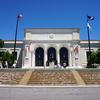More about Martha and Mary Magdalene

Sr. Contributor
Lost art always has a special allure, but when a piece by Caravaggio is the art in question, like Martha and Mary Magdalene, it’s always better found.
No offense, Georges de La Tour and Orazio Gentileschi, but Caravaggio blows the competition for best painting of Martha and Mary Magdalene out of the water. After all, he is the master of chiaroscuro. Caravaggio’s trademark dramatic lighting communicates the spirituality behind this biblical scene. Also known as The Conversion of the Magdalene, this painting depicts the moment in which Mary Magdalene’s sister Martha convinces her to give up her life of sin for Christianity. Caravaggio resorted to his favorite device to bathe Mary Magdalene in an ethereal glow in order to illustrate the moment of her revelation.
Despite the actual lack of sex and and scandal around the biblical figure of Mary Magdalene, there is plenty of conjecture about who she really was. The Bible really only peripherally mentions her, which perhaps is what makes our imaginations run so wild with stories of who she might be and how she became known as an ex-prostitute who became Jesus’ wife. In an effort to downplay her influence, early Church leaders deliberately combined stories of Mary Magdalene with other women whom the Bible explicitly identified as sinners. Sounds like people have always been scared of powerful women.
But Caravaggio helped Mary Magdalene get her place in the spotlight, quite literally at that. This painting comes from Caravaggio’s early career in Rome. After the artist’s short temper escalated an argument into a deadly sword fight, Caravaggio had to flee the city. This wasn’t the last time Caravaggio’s temper would get the best of him, but, unfortunately, we don’t know much else about his personal life.
The history of Martha and Mary Magdalene is as equally mysterious as Caravaggio. Before the painting appeared at a 1971 sale at Christie’s auction house, scholars had presumed the painting was lost, as they had only known about it from a copy in the collection of the Christ Church college of Oxford University. When the painting went up for sale, the Detroit Institute of Arts knew they had to have it. The only problem was, that they didn’t have the money for it. Fortunately, the Kresge Foundation provided $600,000, and Eleanor Clay Ford covered the other $500,000. The Fords didn’t just fund the purchase of a single painting. From 1924 to 1945, Eleanor and her husband Edsel donated most of the money that made the Detroit Institute of Arts the internationally-renowned museum that we know today. In addition to their generous philanthropy, Edsel and Eleanor also had an impressive collection of their own that boasted pieces by Fra Angelico and Paul Cézanne, just to name a few.
Sources
- Carroll, James. “Who Was Mary Magdalene?” Smithsonian Magazine. June 2006. Smithsonian Institution. https://www.smithsonianmag.com/history/who-was-mary-magdalene-119565482/. Accessed 17 June 2021.
- Dallas Museum of Art. “Caravaggio: Martha and Mary Magdalene.” Exhibitions. https://dma.org/Caravaggio. Accessed 21 June 2021.
- Davies, Penelope J.E., Frima Fox Hofrichter, Joseph Jacobs, Ann M. Roberts, and David L. Simon. Janson’s Basic History of Western Art. 8th edition. Upper Saddle River, NJ: Pearson Education, Inc., 2009.
- Detroit Institute of Arts. “Martha and Mary Magdalene.” Collection. https://www.dia.org/art/collection/object/martha-and-mary-magdalene-362…. Accessed 17 June 2021.
- Edsel & Eleanor Ford House. “The Ford Family.” https://www.fordhouse.org/about/the-ford-family. Accessed 21 June 2021.
- Hodges, Michael H. “Edsel & Eleanor Ford House to sell rare Cezanne watercolor, priced at $25m.” The Detroit News. 26 August 2020. https://www.detroitnews.com/story/entertainment/arts/2020/08/26/edsel-e…. Accessed 21 June 2021.
- Kramer, Hilton. “Detroit Institute Buys a ‘Lost’ Caravaggio.” The New York Times. 15 January 1974. https://www.nytimes.com/1974/01/15/archives/detroit-institute-buys-a-lo…. Accessed 21 June 2021.
- Sarah Pruitt. “Who Was Mary Magdalene: Wife, Prostitute, or None of the Above?” History.com. 2 April 2021. https://www.history.com/news/mary-magdalene-jesus-wife-prostitute-saint. Accessed 17 June 2021.
- The National Gallery. “Michelangelo Merisi da Caravaggio.” Artists. https://www.nationalgallery.org.uk/artists/michelangelo-merisi-da-carav…. Accessed 21 June 2021.
Featured Content
Here is what Wikipedia says about Martha and Mary Magdalene (Caravaggio)
Martha and Mary Magdalene (c. 1598) is a painting by the Italian Baroque master Michelangelo Merisi da Caravaggio. It is in the Detroit Institute of Arts. Alternate titles include Martha Reproving Mary, The Conversion of the Magdalene, and the Alzaga Caravaggio.
Like several other works of the period, the painting adheres to the medieval traditions, firstly that the sisters Mary and Martha referred to in the Gospels were Mary Magdalen and Martha of Bethany, and secondly that Mary Magdalen was before her conversion a courtesan. Now the elder sister is regarded as a different figure, Mary of Bethany, and Mary Magdalen's respectability has been reinstated. In this picture, Martha, already converted by Jesus, argues with her sister to win her over to a virtuous life.
Check out the full Wikipedia article about Martha and Mary Magdalene (Caravaggio)














